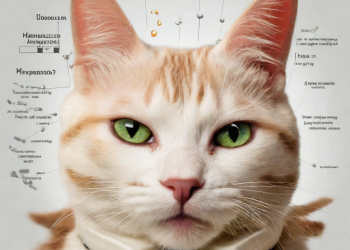Pregnant cat belly: everything you need to know
If you have a cat at home and suspect that she is pregnant, it is important that you know what to expect and how to properly care for her during this stage. Researching the subject, I have discovered that a pregnant cat belly is one that contains the future kittens in its uterus. Below, I will explain everything you need to know about this process and how to provide the best care for your cat during her pregnancy.
Pregnant cat belly?
Discover everything you need to know about pregnancy in cats and how to care for your pet during this important stage.
Don’t miss this complete guide on pregnancy in cats! You will learn about the symptoms, special care, proper nutrition and much more. In addition, we will give you useful tips to prepare your cat for birth and care for newborn kittens. Don’t wait any longer and read on to ensure your cat has a healthy and happy pregnancy!
Symptoms of a pregnant cat belly
A pregnant cat belly can present a series of symptoms that indicate her pregnancy status. It is important to be aware of these changes to provide the necessary care for the cat and her future kittens.
Physical changes in the cat
- Increase in abdominal size and weight, evidencing the pregnant cat’s belly.
- Increase in breast size and change in color.
- Increased appetite and food consumption.
- Possible appearance of nausea and vomiting.
Changes in the cat’s behavior
- Greater affection and attention seeking from the owners.
- Greater rest and sleep time.
- Possible aggression or irritability due to hormones.
Other symptoms to look out for
- Greater sensitivity to odors.
- Increased urinary frequency.
- Possible hair loss.
Observing these symptoms in a pregnant cat belly can help identify her condition and prepare to provide her with the necessary care during her pregnancy.
III. Duration of pregnancy in a cat
A pregnant cat belly goes through a gestation period that has its own duration and stages. It is important to know these aspects in order to provide the necessary care during this time.
A. Average gestation time
The duration of pregnancy in a pregnant cat belly is usually approximately 63-65 days, although it can vary slightly depending on various factors.
B. Factors that may affect the duration of pregnancy
- Age of the cat: Younger cats tend to have shorter pregnancies, while older cats may have longer gestations.
- Number of pups: Litter size can also influence the duration of pregnancy.
- Cat’s Health: The cat’s health conditions can affect the duration of the pregnancy.
C. Stages of pregnancy in a cat
The pregnancy of a pregnant cat belly is divided into three main stages:
- Initial stage: During the first weeks, the cat may experience nausea and changes in her appetite.
- Intermediate stage: At this point, the pregnant cat’s belly will begin to show an increase in its size and weight.
- Final stage: Near the end of pregnancy, the cat will look for a quiet place to give birth and prepare for delivery.
Care during a cat’s pregnancy
The pregnant cat belly requires special care to ensure her health and that of her future kittens. Below are the most important aspects to take into account during this stage:
Proper nutrition
- Nutritional requirements during pregnancy: The pregnant cat needs a balanced diet rich in proteins to ensure the proper development of the kittens.
- Recommended and prohibited foods: It is important to provide the cat with a high-quality diet and avoid foods that may be harmful to her and her babies.
Exercise and physical activity
- The pregnant cat’s belly must remain active, but without making excessive efforts. Moderate exercise will contribute to your well-being during pregnancy.
Visits to the vet
- It is essential to carry out regular check-ups with the veterinarian to ensure that the cat is in good health and to detect any problems in time.
Other important care
- Maintain a calm and stress-free environment for the cat.
- Provide a comfortable and safe place for you to rest.
- Administer medications prescribed by the veterinarian, if necessary.
Birth of a pregnant cat
The birth of a pregnant cat belly is a crucial moment that requires special care and attention. Below are the most important aspects to take into account during this process:
Signs that labor is approaching
- The cat may become restless and look for a quiet place to give birth.
- You may experience a decreased appetite and increased attention to your genital area.
- The cat’s abdomen may contract more frequently, signaling the start of labor.
Preparation for childbirth
- It is important to prepare a comfortable and quiet place for the cat to give birth, preferably a box with soft blankets.
- Have your veterinarian’s contacts on hand in case any complications arise during delivery.
- Stay calm and be prepared to assist the cat if necessary.
Development of labor
- A cat’s birth can last several hours, during which the cat will expel each of her kittens.
- It is important to ensure that each kitten is born wrapped in its amniotic sac and that the cat cleans it and stimulates it to breathe.
- If the cat experiences difficulties during delivery, it is crucial to seek veterinary help immediately.
Postpartum care
- Once all the kittens have been born, it is important to make sure the cat breastfeeds them and keeps them warm.
- The cat should be provided with a quiet, comfortable place to recover from the birth.
- It is advisable to schedule a visit to the veterinarian to ensure that both the cat and her babies are in good health.
Risks and complications during a cat’s pregnancy
The pregnancy of a pregnant cat belly can present certain risks and complications that are important to take into account to ensure their health and that of their babies. Some of the aspects to consider are:
Common health problems in pregnant cats
- Nutritional deficiencies: A pregnant cat may experience deficiencies in certain nutrients during pregnancy, which can affect her health and that of her kittens.
- Infections: Pregnant cats are more susceptible to infections, so it is important to maintain a clean environment free of pathogens.
- Complications during childbirth: Some cats may experience difficulties during childbirth, such as the inability to expel their babies naturally.
How to prevent and treat these complications
- Proper nutrition: Providing a balanced, nutrient-rich diet is essential to prevent nutritional deficiencies in a pregnant cat.
- Veterinary control: Make periodic visits to the veterinarian to monitor the cat’s health and detect any problems in time.
- Care during birth: Be prepared to provide assistance during birth in case the cat presents complications.
When is it necessary to go to the vet
If any symptoms of discomfort or complications are observed in a pregnant cat belly, it is crucial to seek veterinary care immediately. Some warning signs include lack of appetite, lethargy, abnormal vaginal discharge, or difficulty breathing.
In summary, being informed about the possible risks and complications during a cat’s pregnancy is essential to ensure her well-being and that of her kittens. With proper care and timely attention, it is possible to minimize these risks and enjoy a rewarding experience when witnessing the birth of new kittens at home.
Caring for newborn kittens
Once the pregnant cat belly has given birth, it is important to pay special attention to the care of the newborn kittens. Here are some guidelines to follow:
Food and basic care
It is essential to ensure that kittens receive adequate nutrition. The pregnant cat’s belly will provide breast milk, but if there are problems with breastfeeding, supplementation with kitten formula may be needed. Additionally, it is important to keep kittens in a warm, clean environment to promote their health and well-being.
Development and growth of kittens
Newborn kittens will experience rapid growth during the first weeks of life. It is crucial to monitor their development to ensure they are reaching the appropriate milestones in terms of weight and motor skills.
How to help the cat take care of her babies
The pregnant cat belly will need support to care for her babies. This may involve providing a quiet, safe place for her to nurse the kittens, as well as providing assistance if she appears to be having difficulty caring for them.
In summary, caring for newborn kittens is essential to ensure their health and well-being, as well as to support the pregnant cat belly in her role as mother.
What to do if you do not want the cat to have babies?
If you do not want your pregnant cat to have babies, there are options to control reproduction safely and effectively. Below are some alternatives to consider:
Birth control methods for cats
- Feline contraceptives: There are medications that can be used to prevent pregnancy in cats. However, it is important to consult with a veterinarian before administering any type of medication to a pregnant cat.
- Supervision and separation: Keeping your female cat separate from male cats during her heat cycle can help prevent unwanted pregnancy.
Advantages and disadvantages of sterilization
- Sterilization is a surgical procedure that permanently prevents the cat from reproducing.
- Among the advantages of sterilization are the prevention of unwanted pregnancies, the reduction of the risk of certain diseases and the control of the cat’s behavior.
- On the other hand, some disadvantages may include risks associated with surgery and possible changes in the cat’s metabolism and weight.
How to sterilize a pregnant cat
In the case of a pregnant cat belly, sterilization may be more complicated, but it is still possible. It is recommended to consult with a veterinarian to evaluate the risks and benefits of this procedure in a pregnant cat and make an informed decision.
Myths and truths about pregnant cats
Pregnant cat bellies are often the subject of myths and popular beliefs that can cause confusion. It is important to separate fact from fiction when it comes to feline pregnancy. Here we analyze some of the most common beliefs and their veracity:
Popular beliefs about pregnant cats
- A pregnant cat belly will always look for a quiet place to give birth.
- Pregnant cats should eat for two.
- It is dangerous to pet a pregnant cat.
- Pregnant cats can have kittens from different fathers.
What is true about them?
While some of these beliefs may have some truth, it is important to understand the reality behind each one:
- While many cats will look for a quiet place to give birth, not all do, and some may give birth in unexpected places.
- While pregnant cats need a balanced diet, it is not necessary to overfeed them. A moderate increase in the amount of feed is sufficient.
- Petting a pregnant cat is not dangerous, as long as it is done gently and her space is respected.
- It is possible for a pregnant cat to have kittens from different fathers if she has multiple encounters with different males during her heat cycle.
Importance of being correctly informed about the subject
It is crucial to demystify misconceptions about pregnant cats to ensure their well-being and that of their babies. Being adequately informed about feline pregnancy is essential to provide the necessary care and guarantee a healthy pregnancy process.
Conclusions
In short, properly caring for a pregnant cat belly is crucial to ensure her health and that of her babies. Some key points to keep in mind include:
Importance of caring for a pregnant cat belly
- The well-being of the cat and her babies depends largely on the care she receives during pregnancy.
- Good nutrition, regular visits to the veterinarian and a calm environment are essential for the healthy development of kittens.
Benefits of having a pregnant cat belly at home
- Witnessing the miracle of kitten birth can be an exciting and rewarding experience for the entire family.
- The presence of a pregnant cat can teach children about responsibility and care for animals.
Final recommendations
- If you do not want the cat to have babies, it is important to consider birth control methods or sterilization to avoid unwanted pregnancies.
- It is crucial to be correctly informed about the care of a pregnant cat’s belly in order to provide the necessary care.











